Support for missions
Contents of this page
| PLATO CCD |
| CHEOPS CCD |
| Euclid CCD |
| SMILE CCD |
| Euclid near-infrared detector |
| Gaia mission support |
PLATO CCD
The PLATO CCD detector is a large format (8x8cm, 4kx4k pixels) back-illuminated device. It is custom-made by Teledyne e2v to achieve the very stringent requirements imposed by the PLATO mission, in particular a readout frequency of 3 megapixels per second, while still maintaining low readout noise.
The PLATO mission, planned for launch by 2026, will use 26 cameras and a total of 104 CCDs to discover a great number of exoplanets among which are expected to be several Earth-like planets around solar-type stars in the neighbourhood of the Sun.
The PLATO CCD activity within the Payload Validation Section supports Teledyne e2v's qualification programme for this detector, and supports the PLATO science community in ensuring that the PLATO performance can be met. The support consists of the detailed characterisation of the detector's performance, in particular after irradiation, to simulate the in-orbit operation of the CCD.
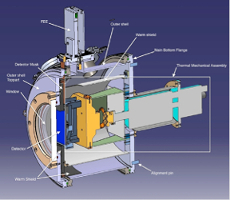 |
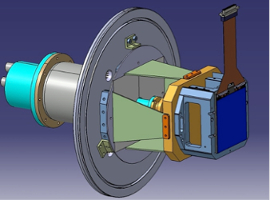 |
| Schematic diagrams of the PLATO CCD test cryostat. The cryostat is cooled via a cryotiger. The CCD227 directly interfaces to the cryostat via a transport jig, to minimise handling risks. Credit: ESA | |
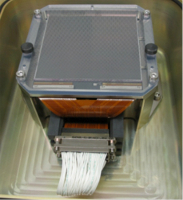 |
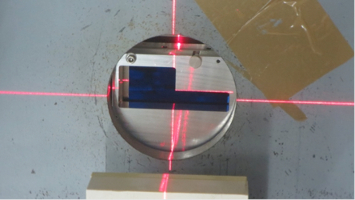 |
| PLATO CCD: (left) a CCD270 full frame version and (right) an irradiation mask with a laser alignment mark, before irradiation. Credit: ESA | |
CHEOPS CCD
The CHEOPS mission will measure the bulk density of exoplanets, in the size/mass range of super-Earths to Neptunes, orbiting bright stars, and will provide suitable targets for future in-depth characterisation studies of such exoplanets.
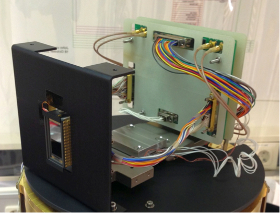 |
| CHEOPS-type CCD in test bench. Credit: ESA |
To reach its science objectives, CHEOPS will be able to detect an Earth-size planet transiting a G5 dwarf star of 0.9 RSun with 6 ≤ mV ≤ 9. Since the depth of such a transit is only 100 ppm, this requires a photometric precision of 20 ppm in six hours of integration time. This precision will be achieved by using a single, frame-transfer, back-illuminated CCD detector with 1024×1024 pixels and a pixel pitch of 13 µm. The detector is an existing e2v CCD47-20 inverted mode CCD, operated at about −40°C. This device is chosen for its high Technology Readiness Level, as required to fit the tight development schedule and cost cap for a Small (S-class) mission. The detector will be mounted in the focal plane of an approximately 33 cm diameter, f/8, on-axis Ritchey-Chrétien telescope; it will be passively cooled with a thermal stability < 10 mK.
The CHEOPS CCD activity within the Payload Technology Validation section supports the procurement by ESA of this detector, as well as the development of the instrument by the community during the early stages of the project. The support consists of the detailed characterisation of the detector's performance in particular with respect to quantum efficiency and stability of the operating parameters after irradiation of the CCD.
SMILE CCD
The SMILE mission will investigate the interaction between Earth's protective shield – the magnetosphere – and the supersonic solar wind. X-ray and ultraviolet imagers are proposed to study global distributions of auroras, along with instruments to measure the energetic particles in the solar wind, and changes in the local magnetic field.
The Soft X-ray Imager (SXI) consists of a lobster-eye telescope built from micro-pore optics, in combination with a CCD-based focal plane.
Given the short development time and tight cost cap for the SMILE mission, the detector needs to have a relatively high Technology Readiness Level. It has therefore been decided to base the detector on the PLATO CCD270 (Teledyne e2v (UK) Ltd.), with minor modifications to improve radiation hardness, but making use of its advanced qualification status. The focal plane will be made out of 2 PLATO-size CCDs (81 mm x 81 mm each), readout in an asymmetric (1:6) Frame Transfer mode, with 6x6 pixel on-chip binning, at 100 kHz super-pixel rate. The CCDs will be cooled passively to about -100°C.
The SMILE CCD activity within the Payload Technology Validation section supports the procurement by ESA of this detector. In particular, the section will provide – as early as possible verification – a verification of the performance as a soft X-ray photon detector in SMILE operating conditions. Support to the development of the instrument by the SMILE-SXI consortium during the early stages of the project will also be provided.
Euclid CCD
The Euclid mission, planned for launch in 2021, is designed to provide important new insights into the 'dark side' of the Universe, namely 'dark matter' and 'dark energy', both key components of the current model for the formation and evolution of the Universe. To achieve this goal, the Euclid payload has two instruments, one of which – a large focal plane of 36 CCDs – is designed to measure with unprecedented accuracy the shape of several million galaxies over a large fraction of the sky. The instruments are provided by the Euclid Consortium.
The Euclid CCD detector is a back-illuminated, 4kx4k pixels (5cmx5cm), 40-µm thick, and low-noise (< 4 e- rms) device custom-made by Teledyne e2v to be sufficiently sensitive to detect faint, old, and distant galaxies.
The Euclid CCD activity within the Payload Validation Section supports the Euclid mission project at ESA and the Euclid science community. The support consists of the characterisation of the detector, in particular after irradiation, in order to simulate the six-year in-orbit operation of the CCD, and with a focus on mission performance. As an example of the latter, a Euclid-like scene projection system has been developed to investigate the accuracy of the galaxy shape measurement after irradiation.
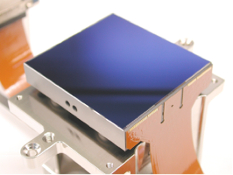 |
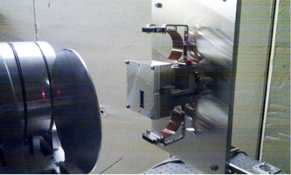 |
| Left: A Euclid CCD273. Right: The CCD with the irradiation mask. Credit: ESA | |
Euclid near-infrared detector
The HAWAII-2RG detector from Teledyne has been linked to a SIDECAR ASIC and both have been integrated in a test set-up allowing the measurement of dark current, readout noise, latency, quantum efficiency, and sub-pixel variations. The main support from the Payload Technology Validation section to the Euclid mission near-infrared detectors concerns investigating latency and sub-pixel variations measurements for this detector.
For the cross-hatched tests, a spot projector mounted on a 3-axis translation stage projects anF#10 beam on the detector. Scanning pixels with a sub-pixel step with the spot projector will assess the impact of cross-hatched pixels on photometry as well as on centroid computation.
For the persistence investigation, the following tests for a detector at 100K are being performed:
- persistence test for three wavelengths below and above full-well illumination in flat-field configuration
- persistence test for different reverse biases in spot configuration
- Impact of the short wavelength flash test used as mitigation technigue as described in McLeod and Smith (2016).
Gaia mission support
The Gaia space astrometry mission was launched on 19 December 2013. Its primary goal is to survey more than one billion stars in our Galaxy (the Milky Way) and beyond.
The first satellite to perform astrometry was ESA's Hipparcos mission, which was launched in 1989 and operated until 1993. Using photomultiplier detectors – the technology of the time – Hipparcos pinpointed more than 100 000 stars, 200 times more accurately than ever before. Now, by using custom-made CCDs, Gaia will revolutionise our view of our galactic neighbourhood.
Within the laboratories of the Payload Technology Validation section, a test bench is being used which allows engineers to perform measurements on the same type of CCD detectors that are used on the Gaia payload. Gaia scientists are then able to compare data received from the satellite with data acquired with this test bench. This provides them with valuable extra information that they can use to extract the best science out of this very sophisticated mission.
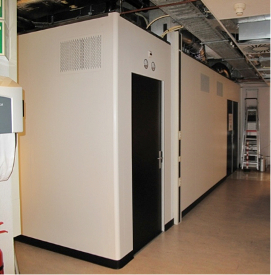 |
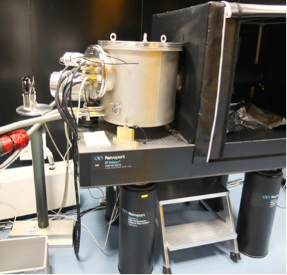 |
| The Gaia CCD test bench cleanroom: view of the exterior (left) and interior (right). Credit: ESA | |
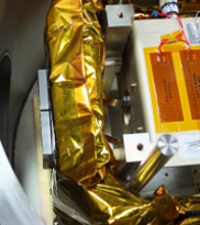 |
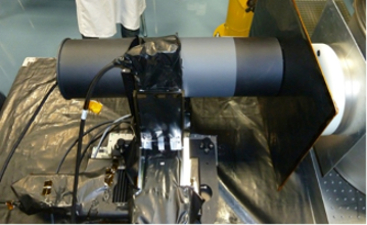 |
| Left: Two Gaia CCDs mounted in the test chamber. Right: The illumination system. Credit: ESA | |
